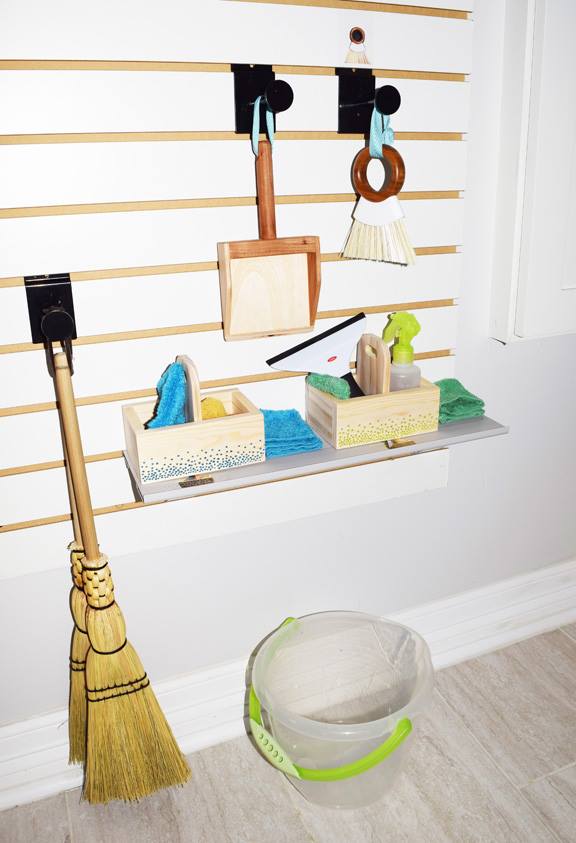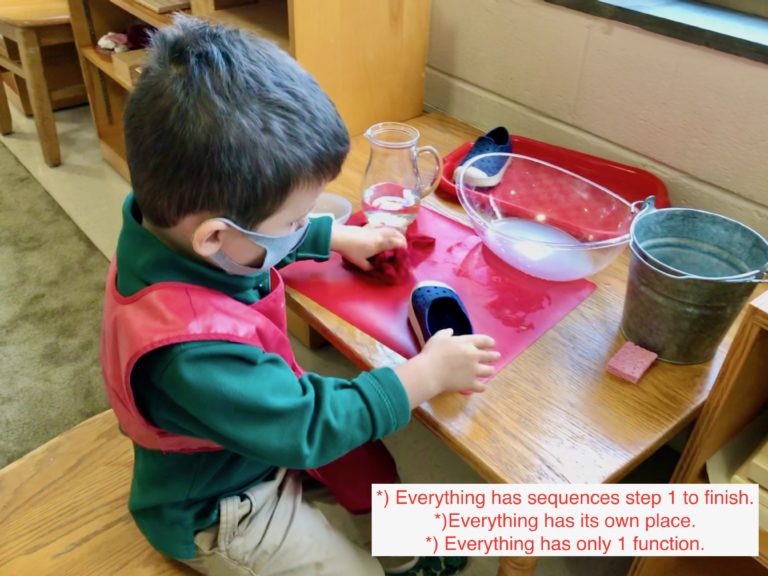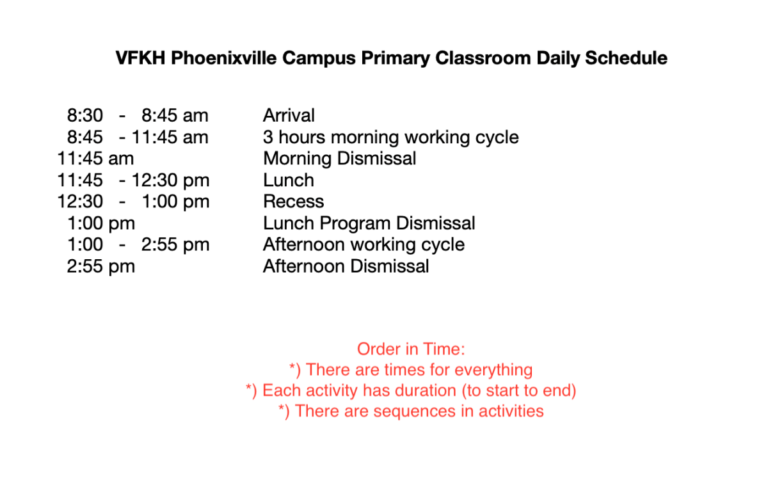You may have heard a lot of parenting advice saying, “The key to parenting is consistency. You have to be consistent with your children.” What is consistency? And how does consistency work according to the world of Montessori? How can you, as parents, help your child through offering consistency, order, and routines at home?
The Absorbent Mind
Dr. Maria Montessori found that during the period from birth through 6 years old a child’s brain is like a sponge soaking up everything around him/her, not discerning good or bad. She called this, “the absorbent mind”. The child absorbs everything in his/her environment as the natural position or condition of things (normal). This relates not only to objects, but climate, rules, culture, language, the treatment of adults, emotions, feelings, the way of speaking, and relationships. He/she will absorb and adapt to the environment that’s presented to them.
“The child absorbs it. The things the child sees are not just remembered; they form part of his/her soul. The child incarnates in him/himself all the world about him/her that the child’s eyes see and ears hear.”
Maria Montessori, The Absorbent Mind
Human Tendencies
Dr. Montessori also discovered there are some unique traits that are inherited from the time of birth that guide human development and motivate human behavior in fulfilling his/her needs, progressing as an individual, and in social groups. These traits are called human tendencies. One of the most important human tendencies to understand as parents is the order, need, and drive to classify and organize the mind. External order becomes internal order.

Order helps children:
- To understand the environment around them.
- To eliminate confusion/give clarity of thought in their mind.
- To learn predictability that leads to building trust and a sense of security.
- To see and learn relationship building.
- To see and learn how things relate to the child and their environment.
- To develop the logical, mathematical, and calculating mind.
A child has twofold of sense of order. One of theses is external and pertains to his perception of his/her relation with his/her environment. The second is internal and makes him/her aware of the different parts of his/her own body and their relative positions.
Dr. Montessori, The Secret of Childhood
Sensitive Period of Order
She also discovered the sensitive period of order, the developmental window of time between 0-3 years of age that’s characterized by a strong inner need where the child shows an extremely strong craving for order, such as routines, consistency, and predictability. These important needs include order in the environment, order in time, and order in adults’ actions.
It seems to him/her at this stage a particularly vital matter that everything in the child’s environment should be kept in its accustomed place and that the actions of the day should be carried out in their accustomed routine.
E.M. Standing, Maria Montessori: Her Life and Work, p. 123
Understanding the importance of the Absorbent Mind, Human Tendency (need) of order and the sensitive period of order, Dr. Montessori created her pedagogy with “order” as the foundation for all.
Imagine how disturbed or frustrated a young child, who without any understanding or verbal ability, reacts to a change in her order. Many temper tantrums can be avoided by having a consistent environment, ground rules, and a predictable schedule.
We look upon this as a kind of senseless desperation calling it a “tantrum.” But in reality, it is the expression of inner disturbance or of an unsatisfied need that has created a degree of tension.
Dr. Montessori, The Secret of Childhood
The external order helps the child to understand that:
- Everything has its place (order in environment).
- Everything has its meaning (order in adults’ actions).
- Everything has its time (order in time).
Order in Environment
We create an orderly environment that:
- Every item has its own place and one place.
- Every item has only one function.
- Every item has its name and only one name.
- Belonging items – the child forms connections between things and people too, for example “This is Mom’s dress.”
Order consists in recognizing the place for each object in relation to its environment and in remembering where each thing should be. This implies that one is able to orient one’s self within one’s environment and to dominate it in all its details.
Dr. Maria Montessori, The Secret of Childhood, p. 52-53
The roles of adults in supporting order in the environment include:
- Understanding that too much stimuli and/or a chaotic environment will create confusion and clutter in the child’s mind.
- Limited quantity of stimuli is best for your child.
- Creating an orderly and simple environment (space in between, accessible, intact, and organizable).
- Providing only purposeful activities, adjusted according to a child’s ability, not too hard or too easy, which help the child successfully organize internally. Therefore a parent’s observation and detailed attention are the keys to creating order.
- Creating zones that are helpful for keeping order for your child. For example, an eating area = a dining table, the sleeping area = the child’s bed, the working area = the working rug or table.
- Adjusting your kitchen and bathroom to be more suitable and reachable for your child’s safety and independence.
- Putting things back in their exact places.
- Not taking another thing out before closing or putting items back in their exact place.
Order in Time and Routine
The routine, schedules, and structured life cycle that adults build, help the child to build his/her logical mind (predictability) and allows a child to feel secure and safe because the child knows what to expect to prepare his/her sense of orientation.
It helps the child understand :
- There are times for everything. For example, time to eat dinner, time to go to bed, and time to go to school.
- There are sequences in activities. For example, cook dinner, set the table, eat dinner, and wash the dishes.
- Each activity has a duration from start to end.
Order in Adults’ Actions
The roles of adults include:
- Be fair and consistent with your actions and requests for everyone in the environment.
- Be simple, clear, and consistent with your communication style and requests.
- Be in one accord and unity about rules between both parents.
- Be consistent with the message that rules are made for everyone’s safety.
In their first year, they derive their principles of orientation from their enviroment which they must later master. And since a child is formed by his environment, he needs precise and determinded guides and not simply some vague constructive formulae.”
Dr. Montessori, The Secret of Childhood, p. 53
Parents, thank you for reading this very important information. These may seem like a lot of details and you may feel overwhelmed with the thought of adding so much “order” in your child’s life, but we can build this foundation together one layer at a time from school and home. Your child receives “order” every day from our Montessori environment. Your help to continually work to build this order in your home environment will help your child have peace and stability and eliminate hard transitions and confusion in your child’s life. The amazing power of order that we create helps the children develop their independence, self-discipline, confidence, self-esteem, inner peace, concentration, and executive functioning skills.
Resources
Below are links to videos that support a Montessori environment at home.

